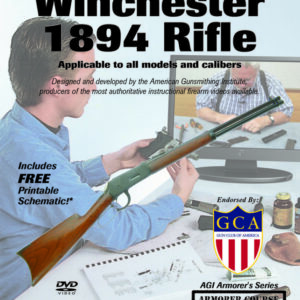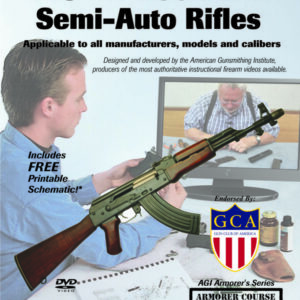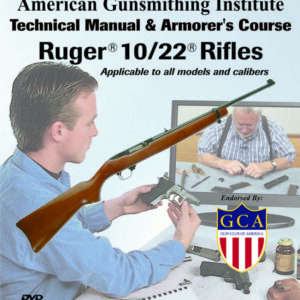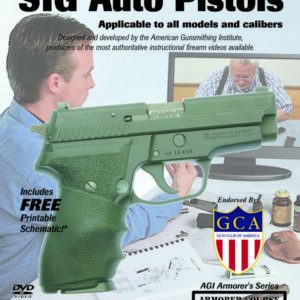Description
Bob Dunlap understands the design, function, and repair of these extremely popular deer woods guns as well as anyone. These semi-auto and pump action guns are, with the exception of the force causing the action bars to move (hot gas or your hand), are practically identical. In fact, the trigger groups (as well as those on their 870 and 1100 shotguns) are identical. This course covers all of the models and variations of this series of rifles.
Using a cut-a way gun and the important variants, Bob shows you everything you need to know about getting them apart and back together again and understanding the changes along the way and why they were made. The weaknesses of the versions, and their strengths, are shown and explained as only the master can. If you want the quick course on how to maintain these guns, and operating as intended, then this course is for you (if you want the long course, look into our basic 108 hour Professional Gunsmith Course.)
Among the items covered are:
History
- Discussion of the origins of the guns in 1949, and the reason why they became an instant hit with hunters, particularly in the Midwest, Northeast, and South
- Short history of the model succession
- Mention of their related successors, the model 552 and 572 rim fire rifles
Design & Function
- Explanation and demonstration of the bolt lock-up and the unexpected precision of the multiple lugs and recesses
- Observe how bolt cam pins interact
- Interaction of sear with hammer shown, and hammer plungers function with action bar lock/trigger disconnector
- Floating hammer operation shown
- Old and new style magazine catches explained and operation shown
- Action of disconnector lever on sear shown
- Entire fire, action unlock, trigger/sear disconnect and reset sequence shown in detail
- Method of trigger stop shown and how to get Crud clearance if necessary
- Identifying right hand and left hand trigger housings, newer models plastic and older models aluminum housings (plates)
- Safety operation is shown, and how to correct the problem if the safety does not work as designed. Once again, Bob expresses the oft-heard dictum, Always work on the cheapest part
- Operation of trigger & sear, connection and disconnection, as well as the safety, shown outside of gun
- Bolt carrier and bolt removed and inspected, locking lugs in barrel extension shown, and assembly manner of barrel extension and recoil lug to barrel shown
- Attachment and operation of bolt carrier to op rod shown, and common failures mentioned. Some later guns have the bolt carrier brazed to the action bars
- Mention made that most parts for earlier guns, 740, 742, and 760, are no longer available, but that later model parts can generally be made to fit those guns
- Operation of extractor and ejector explained and shown. Replacement method for early extractors discussed, and why the ejector must not extend past the bolt face rim
- Potential problems with bent action bars mentioned
- Magazine retention explained and shown, as well as adjustments that can be made to trigger housing and magazines to get them to work. Differences between old model and new model magazines discussed
- Loading cycle shown
Differences between Pump and Semi-Auto
- Gas system on 740 shown and explained
- “Timing Delay” explained
- Action bar lock piece functions as disconnector in semi-auto
- Problem with 740-receiver groove battering by the bolt lugs upon recoil shown and explained, and the bolt lock piece designed to cure the problem on the 742s
- Bar type ejector on early 740s mentioned and function described
- Difference between 740 and 742 forearm attachment shown and explained, and why the newer is improved
- What the two-legged spring thingy at the bottom front of the receiver is and is supposed to do
- Differences between the 7400 and the earlier guns detailed
- Reduction from nine bolt-locking lugs to three, and the clever way Remington dispensed with the need for the bolt lock
- Fore end attachment reverts to 740 styles, and why it works now
- Gas nozzle change, and why. Also mentioned are consequences of nozzle damage
Disassembly
- Extensive disassembly (essentially 4 different guns), parts not removed have removal described
- Barrel retention methods shown, methods of removal shown and described, easy to make special removal tools shown and described
- Variations of mag tube spacers described
Cleaning & Lubrication
- AGI cleaning & lubrication methods shown, along with the reasons for their use
Reassembly
- Making sure, you have no parts left over
- Why you should not confuse the bolt cam pin for the sear pin or Oops
- How to repair and replace a broken barrel-attaching bolt
- Bob gives you bedding and stock mod tips for improving accuracy
- Semi-Auto differences described
- Disassembly and reassembly of semi-auto shown
- Common problems described and discussed
- Gas nozzle adjustment tool shown
- Accuracy modification trick shown
- New model mag catch and spring, disassembly/reassembly shown
- Magazine fitting shown
- Difference in semi-auto magazine shown
Accessories
- What to use
- What to avoid and why
Final Thoughts
- Correcting early opening on semi-auto
If you noticed how often the terms “explanation” and “visual demonstration” are used, you may be getting some idea of why this course is necessary for any Remington 740/760 owner, or someone who intends to be.
View a sample of the content of this course below.
[youtube https://www.youtube.com/watch?v=B47bQxZxR-0]




